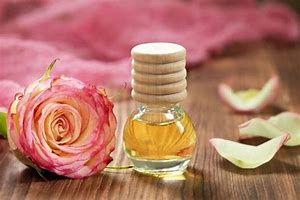Essential Oils- Absolutes vs Essential Oils






Essential Oils- Absolutes vs Essential Oils
Rosa centifolia is particular to the French city of Grasse, known as the perfume capital of the world.
What better example to explore the difference between an essential oil and absolute than Rose Absolute production from Rosa centifolia is prevalent in Morocco, whereas Rosa damascena is primarily distilled in Turkey and Bulgaria, but also in Iran and parts of the former Soviet Union.
The difference in the chemical composition between the essential oil and the absolute are well researched . A substantial concentration of phenyl ethyl alcohol is present in the absolute, yet only very little in the essential oil. The difference in fragrance is dramatic.
Absolutes have a considerably more complex composition than essential oils, which is a consequence of their production by extraction. To end up in the extract, a plant molecule only needs to dissolve; there is no need to evaporate. Molecules that do not readily evaporate are not found in essential oils but may well end up in an absolute. Pragmatically, absolutes are mostly used-as indicated by their usually rather lofty prices-for luxurious perfumery.
Antifungal Activity
Classical studies were conducted in the 1960s by J.C.Maruzella and in the 1970s by J. Pellecuer. Essential oil efficacy against fungi and yeasts has been demonstrated in vitro, but again, no mechanisms have been derived from these experiments. It was shown in the 1990s that the sterol insensitive key enzyme HMG CoA reductase in fungi can be inhibited by essential oils.
Anti-inflammative Activity
Classic studies on the anti-inflammative effects of Chamomile (Matricaria reculita) were published in the 1980s. Many sesquiterpene hydrocarbon components of essential oils have been demonstrated to have anti-inflammative effects on tissue. While the cellular and biochemical mechanisms are not clearly understood, sesquiterpene hydrocarbons have an obvious capacity to dissipate free radicals, the agents of inflammation.
Antiviral Activity
In the first sixty years of the twentieth century, viral diseases were not as well understood as they are today, and they were culturally overshadowed by bacterial infections. Human Industriousness had created effective antibiotics for bacterial infections. For viral diseases there was... nothing.
The beginning of the AIDS crisis established the concept of a virus as something radically different from a bacterium in the public consciousness. This was also the time that the absence of industrial antiviral drugs was noticed. However, for those open to planbt medicine, essential oils came to the rescue.
In 1987 Lembke and Deininger published the ground breaking study about antiviral (and also antibacterial and antifungal) properties of essential oils and their components. Many more studies followed worldwide, corroborating their findings.
Today, this study seems prescient as it foreshadowed the recognition of nonselective effects. The efficacy of many oils and their components against a wide range of viruses has been demonstrated in vitro and occasionally in clinical trials. Different cellular mechanisms for the observation have been proposed. The stunning efficacy of all or almost all essential oils against herpes lesions is probably the best example for a curious mind to experience the true meanings of nonselective effects first hand.
Contributors To Aromatherapy
Paul Belaiche determined the activity of over forty essential oils vis-a-vis pathogens encountered in common infections. Proteus morgani, Proteus mirabilis, Proteus rettgeri (intestinal), Alcalescens dispar, Corynebacturium xerosa (diphteria), Neisseria flava (sinus and ears) klebsiella pneumoniae (pneumonia), Staphylococcus alba (food poisioning), Staphylococcus aureus (wounds) Pneumococcus, and Candida albicans.
Reference : The Healing Intelligence Of Essential oils- The science of Advanced Aromatherapy: Kurt Schnaubelt, Ph.D.
Articles Latest
- CARDAMON
- CARAWAY
- CANANGA
- CAMPHOR
- CALAMUS
- Calamintha-Calamintha officinalis
- CAJEPUT- Melaleuca cajeputi
- Plant Expression
- Molecular Target: Cell Membrane
- CADE Essential Oil
- CABREUVA
- The Kashmiri rose oil worth millions
- Agarwood: The natural treasure worth more than gold whose heady scent is driving it towards extinction
- Nonselective Binding to Proteins: The Science of Advanced Aromatherapy
- Molecular Target: DNA, RNA, and Gene Expression
- BUCHU - Agothosma betulina
- BROOM - SPANISH - spartium junceum
- BORONiA - Boronia megastigma
- BORNEOL - Dryobalanops aromantica
- Boldo Leaf - Peumus boldus
- Birch White-Betula Alba
Articles-Most Read
- Home
- Balsam Canadian - Abies balsamea
- Copaiba Essential Oil
- Balsam Peru
- Basil French - Ocimum basilicum
- North America: Tea Tree and Monarda-3
- Basil Exotic
- North America: Tea Tree and Monarda-2
- Exploring Transcultural Constants
- Thyme Essential Oil
- Balsam Tolu
- Palma Rosa
- The Bioactivity of Essential Oils
- Benzoin - Styrax benzoin
- Why Pharmacology Cannot Demonstrate Essential Oil Efficacy
- Bay - West Indian - Pimenta racemosa
- Exploring Essential Oil Activity The Conventional Way
- Aromatherapy: An Answer
- Complex information From Plants
- Contacts
